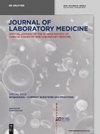POCT血糖仪的比较及干扰因素分析
IF 1.8
4区 医学
Q4 MEDICAL LABORATORY TECHNOLOGY
引用次数: 1
摘要
摘要目的没有多少报道涉及大规模的护理点检测(POCT)血糖比较,并且许多干扰因素影响检测。本研究旨在验证POCT血糖仪的性能,并讨论干扰检测的因素。方法对高1(H1)、高2(H2)、中1(M1)、中2(M2)和低(L)五个葡萄糖浓度组的准确度和精密度进行验证;不同试验方法和试样的比较;并在稀释实验中研究了碘伏的影响。结果64台Accu-Chek Inform II POCT血糖仪(ACI II)中,共有58台合格。在中、高糖浓度组中,POCT仪器的相对偏倚存在比例显著差异(H=15.364,p=0.02)。五组之间的依从性差异有显著性(χ2=21.03,p=0.00);L组的数值高于H1和H2组。精度验证符合《共识》提出的要求。三种检测方法之间存在显著差异。在初步研究中,葡萄糖氧化酶法(Cobas B123)的测量值低于日立血浆己糖激酶法和葡萄糖脱氢酶法对ACI II的测量值(p=0.005和0.003)。三种类型的标本之间没有差异(p>0.05)。在存在碘伏干扰的情况下,葡萄糖结果是不正确的。结论ACI II和Cobas B123(有轻微的负偏差)提供了足够准确的测量,并且可以应用所有类型的血液样本。碘伏是一种消毒剂,会干扰葡萄糖的测量。本文章由计算机程序翻译,如有差异,请以英文原文为准。
Comparison of POCT glucose meters and analysis of the interference factor
Abstract Objectives Not many reports have covered large-scale point of care testing (POCT) blood glucose comparisons, and many interfering factors affect detection. This study aims to verify the performance of POCT blood glucose meters and discusses the factors that interfere with detection. Methods Accuracy and precision verification in five glucose concentration groups-high 1 (H1), High 2 (H2), medium 1 (M1), medium 2 (M2), and low (L); comparison of different test methods and specimens; and also the influence of iodophor was investigated in a dilution experiment. Results A total of 58 out of 64 Accu-Chek Inform II POCT blood glucose meters (ACI II) qualified for testing. A proportional significant difference in the relative bias was observed with the POCT instruments in the intermediate and high glucose concentration groups (H=15.364, p=0.02). There were significant differences among the five groups with compliance rates (χ2=21.03, p=0.00); Group L showed higher values than groups H1 and H2. The precision verification met the requirements issued by the Consensus. Significant differences were found between the three detection methods. The measurement of the Glucose Oxidase Method (Cobas B 123) was lower than that of the HITACHI Plasma Hexokinase Method and the Glucose Dehydrogenase Method on the ACI II (p=0.005 and 0.003) in the preliminary study. No differences were seen among the three types of specimens (p>0.05). The glucose results were incorrect in the presence of iodophor interference. Conclusions The ACI II and Cobas B123 (with a slightly negative bias) provide sufficiently accurate measurements, and all types of blood specimens can be applied. Iodophor, a disinfectant, interferes with glucose measurement.
求助全文
通过发布文献求助,成功后即可免费获取论文全文。
去求助
来源期刊

Journal of Laboratory Medicine
Mathematics-Discrete Mathematics and Combinatorics
CiteScore
2.50
自引率
0.00%
发文量
39
审稿时长
10 weeks
期刊介绍:
The Journal of Laboratory Medicine (JLM) is a bi-monthly published journal that reports on the latest developments in laboratory medicine. Particular focus is placed on the diagnostic aspects of the clinical laboratory, although technical, regulatory, and educational topics are equally covered. The Journal specializes in the publication of high-standard, competent and timely review articles on clinical, methodological and pathogenic aspects of modern laboratory diagnostics. These reviews are critically reviewed by expert reviewers and JLM’s Associate Editors who are specialists in the various subdisciplines of laboratory medicine. In addition, JLM publishes original research articles, case reports, point/counterpoint articles and letters to the editor, all of which are peer reviewed by at least two experts in the field.
 求助内容:
求助内容: 应助结果提醒方式:
应助结果提醒方式:


